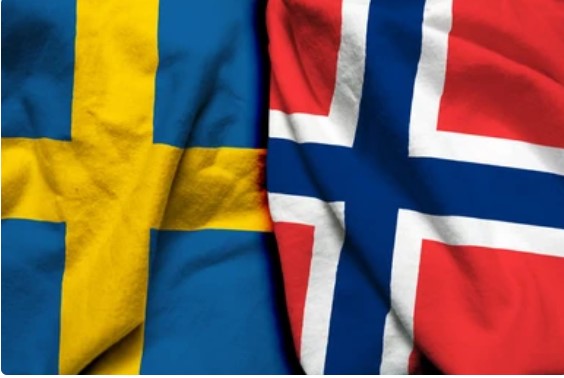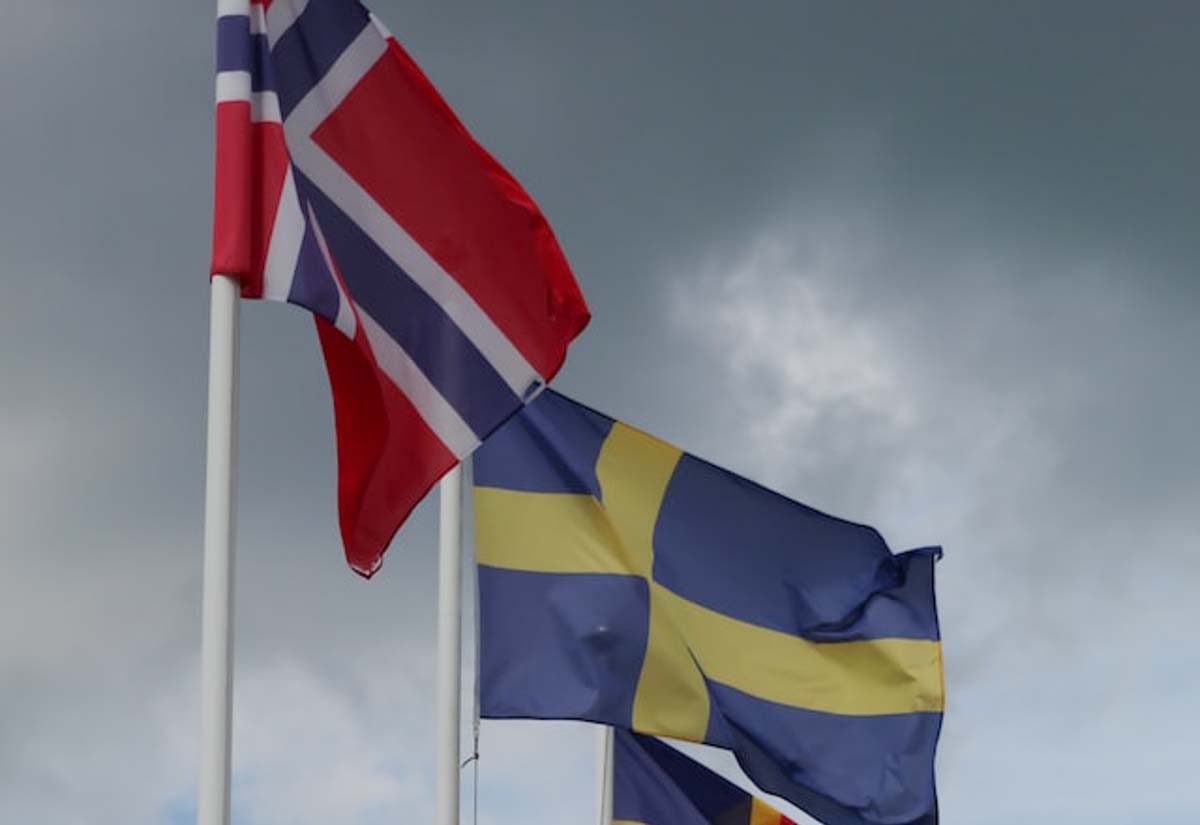
Swedish Vs Norwegian Language Comparison
Swedish and Norwegian are rooted in Old Norse, the language of the Vikings. Both countries have evolved to develop their own distinct languages.
In the Middle Ages, different parts of Norway began to form their own dialects before Norway and Denmark were unified in the 1500s, and Danish became the official language. The two nations separated in the 19th century, after which time the Norwegian variants Bokmål, which resembles Danish, and Nynorsk became the country’s two dialects.
Similar to Norway, a range of dialects originating in Old Norse were spoken in Sweden during the Middle Ages. The Reformation brought about the standardisation of Swedish, which worked to combine aspects of different dialects in the 1500s.

Key takeaways
- Norwegian and Swedish are both relatively easy to learn, though Norwegian is simpler to pick up for English speakers due to its easier pronunciation.
- Grammar in Norwegian is slightly more complex than Norwegian, as Swedish has been simplified over time.
- Both languages are useful for educational and professional opportunities in Sweden and Norway, though there are twice as many Swedish speakers.
- Swedish and Norwegian both have close ties to Danish.
- Many differences exist between Norwegian and Swedish, but native speakers of each often find it possible to communicate due to the similarities between the two in terms of grammar, syntax and vocabulary.
Swedish VS Norwegian: Which One Is Easier?
Several factors determine if Swedish or Norwegian is easier to learn. Still, it is worth noting that they have many similarities and generally are considered to have a comparative level of difficulty.
Let’s explore how these two languages compare in terms of areas like grammar complexity, pronunciation, and resource availability.
Grammar Complexity: Norwegian grammar is slightly more complex than Swedish, retaining more Old Norse features like irregular verbs, gender agreement and other case systems. Swedish grammar has become more simplified over time. For this reason, it takes less time to get an understanding of Swedish.
Pronunciation: In Norwegian, pronunciation is usually similar to English. It is more phonetic than Swedish and has clearer vowel sounds. Swedish has some sounds not found in English that can change depending on the placement of the vowels. As a result, non-natives find Norwegian a more straightforward language in terms of pronunciation.
Resource availability: There are significantly more Swedish speakers than Norwegian, which has led to the availability of a broader range of Swedish learning materials. However, learners will find it easy to find resources for either language, as online courses and textbooks are available for both, and each country has an impressive selection of television shows and movies for additional exposure.
Norwegian
Spoken in: Norway
Number of speakers: 5 million
Related languages: Danish, Swedish, Faroese and Icelandic.
Swedish
Spoken in: Sweden, Finland
Number of speakers: 10.5 million
Related languages: Norwegian, Danish, Faroese and Icelandic
How Close Are Swedish And Norwegian?

Next, we will compare Swedish and Norwegian based on different aspects of language to ascertain the extent of their close relationship.
Vocabulary: Though each language has different variations and dialects, Swedish and Norwegian share a lot of vocabulary, with many words being almost identical or easily understood by speakers of the other language. This is true for both speech and writing, with many cognates existing between the two. Bokmål, the most common standard of Norwegian, is closer to Swedish than Nynorsk.
Syntax: There are some subtle differences between the two languages, but they both follow the same sentence structure of subject-verb-object. Gender agreement for nouns and adjectives is also a feature in both, and they also share verb conjugation patterns. They even approach complex sentences with similar syntax.
Phonetics: Swedish and Norwegian are quite phonetically alike. They share similar long and short vowel sounds, and many consonant sounds are shared between the two, such as t, m, n and a rolled r. However, some subtle differences between the languages include the impact vowel pronunciation has on the meaning of a word, which is primarily relevant in Swedish and variations in pitch.
Grammar: Due to their similar syntax patterns, Swedish and Norwegian share many grammar rules. Both continue to implement the genitive case but have fewer case systems than their Old Norse origins. Regular verbs are conjugated similarly, as is the case when negating verbs and using definite and indefinite articles.
Take a look at these examples, which highlight the close ties between the two languages:
English: I am reading a book.
Norwegian: Jeg leser en bok.
Swedish: Jag läser en bok.
English: It’s a sunny day.
Norwegian: Det er en solrik dag.
Swedish: Det är en solig dag.
Can A Swedish Person Understand Norwegian?
Thanks to the stark similarities between the languages, Swedish and Norwegian speakers generally find it easy to comprehend each other. Aside from a few differences in vocabulary and pronunciation, native speakers will have little difficulty communicating. If you have a strong understanding of either Norwegian or Swedish, you can learn the other language relatively quickly.
Tired of scrolling through the internet for Norwegian grammar?
Start an organised Norwegian course now.
In order to learn fluent Norwegian, we need to repeat it and speak it several times before our brain learns it.
Learn that in our courses!
What Are The Key Differences Between Swedish And Norwegian Language?
Pronunciation: Vowel length can have a greater effect on the meaning of a word in Swedish and is less significant in Norwegian. Sounds like ä and ø can differ between the two.
Spelling: As vowels are simpler in Norwegian, spelling is more phonetic, whereas Swedish can have more difficult spelling patterns that reflect the different treatment of vowel sounds.
Grammar: Pitch and tone feature more in Norwegian, so the grammatical correctness of a sentence will depend on whether you used the word in the correct tone. Similarly, the more complicated rules for vowels in Swedish can affect the accuracy of a sentence and make grammar tricky.
Vocabulary: Due to variations in culture and historical language developments, some words and phrases are unique to each language that non-native speakers cannot understand. The Danish influence on Norwegian and the German impact on Swedish can also create some differences.
Here are a few examples of the slight differences between Swedish and Norwegian:
English: I love to travel.
Norwegian: Jeg elsker å reise.
Swedish: Jag älskar att resa.
English: She went to the store.
Norwegian: Hun gikk til butikken.
Swedish: Hon gick till affären.
How Is Norwegian Different From Swedish?
Due to their mutual intelligibility, Norwegian and Swedish have a lot of commonalities and share similar vocabulary and grammar, though each language has unique slang, local phrases and idioms. Norwegian places more of an emphasis on pitch, while Swedish has more variances in vowel pronunciation than Norwegian.
What Are The Regional Variations Within The Swedish And Norwegian Languages?

Both Norwegian and Swedish can vary depending on the region, with most differences relating to vocabulary or pronunciation.
Swedish Variants
- The north of Sweden, called Norrland; central Sweden, called Svealand; and the south, called Götaland, each have some slight differences in vocabulary and pronunciation unique to that region.
- Swedish is also spoken by some communities in Finland, where Finnish has influenced the language.
- Some of the islands off the coast of Estonia speak a more traditional variation closer to Old Norse than modern Swedish.
Norwegian Variants
- Nynorsk and Bokmål are both accepted standards of Norwegian. Bokmål is closer to Danish, while Nynorsk is more traditional.
- Western and Southern regions in Norway have their own dialects, such as Bergensk and Stavangersk.
- The central region of Trøndelag has unique pronunciations, vocabulary and phrases.
The vocabulary you acquire and how you pronounce sounds depends on where you learn Swedish or Norwegian. These variations can make interactions with people from other parts of the country challenging at times and can lead to some misunderstandings, though most people are aware of the standards for the language that is accessible to most speakers.
Learn fluent Norwegian from your level
Check your level now, and find the right course for you
Our classes has native Norwegians who knows how it feels to learn a language, and will do everything to help you.
Language Evolution And Influence
Swedish and Norwegian are North Germanic languages that have individually evolved from Old Norse. The languages began to form in the Middle Ages when different parts of Scandinavia started to use their own regional variations. As the years progressed, each dialect continued to diverge and develop into languages of their own in regions that went on to become modern-day Norway and Sweden. These languages became standardised in the 19th century and have continued to develop over time.
In the past, Denmark’s control of Norway and Sweden has had an impact on each language, though this is more noticeable in Norwegian. The global influence of English has had a significant effect on both Norwegian and Swedish. While the shared roots of English and Scandinavian languages meant that some words naturally resemble each other, Norwegian and Swedish both have many loanwords that closely resemble or are identical to modern English words.
Comparing Swedish And Norwegian To Other Scandinavian Languages

Danish and Icelandic have also developed from Old Norse and are in the same language family as Swedish and Norwegian. Danish is quite clearly similar to both languages, though it is especially linked with Bokmål, the most widely used standard of Norwegian. Swedish vocabulary and pronunciation deviate further from Danish than Norweigan does.
Icelandic is markedly different from Swedish, Norwegian and Danish. This is due to Icelandic’s stark resemblance to Old Norse, as Iceland has kept more traditional grammar, vocabulary and pronunciation. However, it still shares the same origins as the other Scandinavian languages and some commonalities still exist.
Why Is Norwegian So Similar To Danish?
Denmark and Norway were united in the past, in the 16th century. During this time, Danish became more widely spoken than Norwegian, leading to fewer speakers of the traditional Norwegian dialects. The influence of Danish on Norwegian can be seen in how similar the Bokmål standard of Norwegian continues to be the most popular variation of the language today.
Is It More Useful To Learn Swedish Or Norwegian?
Let’s explore the potential benefits and practicalities of learning Swedish and Norwegian.
Swedish:
- More widely spoken than Norwegian due to Sweden’s larger population and Swedish-speaking communities in Finland and Estonia.
- Sweden has a strong economy and a desirable job market, and professionals speaking Swedish may have more opportunities.
- Sweden has a rich culture, and the language will give you a much deeper understanding.
- Travel in Sweden is more rewarding if you can speak the local language.
Norwegian:
- Norway has an excellent education system. Learning Norwegian will make studying there much easier and more enjoyable.
- Like Sweden, Norway has a fantastic economy and job market.
- Norwegian is similar to Swedish and Danish, making it a great entry point into Scandinavian languages.
- Norway has produced some acclaimed television shows and movies you can enjoy in Norwegian.
A Look At A Norwegian-Swedish Combined Language

With a shared history and strong ties between the Swedish and Norwegian, it is little wonder why people have considered the concept of combining the two languages.
Below, you will find some of the possible benefits and challenges of a shared language between Norway and Sweden.
Benefits:
- Clear communication between speakers of both languages.
- As the languages are already similar, natives of either language could quickly pick up aspects of the other.
- As a new, combined language, clear standards could be set to ensure continuity.
Challenges:
- Norwegian and Swedish are a part of the culture of their unique countries, and locals value and cherish their languages.
- It would lead to a loss of national identity and language diversity.
- Other languages throughout history have already influenced both, and the languages would be lost if they were to combine.
- Education, political and social systems would need to be overhauled to align with a new language.
- Many speakers may struggle to adapt to different grammar and pronunciation rules
Cultural Significance And Representation
Though Norwegian and Swedish have transformed over time, the languages continue to be represented and preserved in several ways, such as through pop culture, music, literature and cinema. Through the likes of television series, newspapers and music, each language stays relevant and contemporary.
The Language Council of Norway helps to ensure consistency in the language and promotes the correct use of Norwegian, while Sweden’s language council works to do the same for Swedish, setting standards and striving to develop the language continually.
What Are Some Resources For Learning Swedish And Norwegian?
There are many great resources to help learners on their language journey with Norwegian or Swedish.
Some of the top resources include:
- Mondly – An online learning platform
- Italki – Tutoring platform where learners can take lessons from native speakers
- Mango Languages – Structured online courses
- The Mystery of Nils – A book that teaches Norwegian through story
- Norwegian Tutor: Grammar and Vocabulary Workbook: A textbook filled with key grammar and vocabulary lessons
- Teach Yourself Complete Swedish: The ultimate beginner’s handbook
- Colloquial Swedish: Conversational Swedish textbook focused on grammar and pronunciation
Tips For Learning Norwegian or Swedish
As a starter you need to find some basic teaching resources. You can check out a language learning app like Duolingo or Babbel. They will teach some vocabulary, get you familiar with pronunciation and basic grammatical structure.
We also offer a basic intro course in Norwegian. Check it out here. Then, when you feel like you’ve got the basics down, it’s time to put it into practice. Find someone to speak with in order to use the language as you would in a real situation. This is an absolutely necessary step. Why not join one of our Norwegian conversation classes here?

You also need to make sure you practice every day. Doing a little every day will ensure you remember the things you go over.
Learn fluent Norwegian in 4 months. Start today.
Did you know that you don’t need all the grammar to speak fluent Norwegian? In our classes we focus just on the necessary vocabulary. So you can learn 3 times faster.
Frequently Asked Questions About Swedish And Norwegian Languages
What Language is Closest to Norwegian?
Danish is the closest to Norwegian, though it is also similar to Swedish.
How Close is Swedish to Norwegian?
Swedish and Norwegian share a considerable amount of vocabulary, grammar structures and pronunciation rules and can be considered sister languages.
What Language is Swedish Closest to?
Swedish is closest to Norwegian and also has many similarities to Danish.
Learn fluent Norwegian in 4 months. Start today.
Did you know that you don’t need all the grammar to speak fluent Norwegian? In our classes we focus just on the necessary vocabulary. So you can learn 3 times faster.

